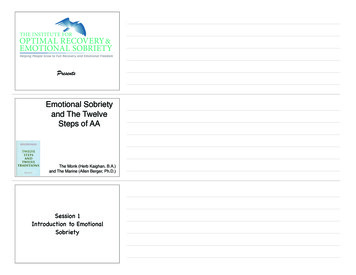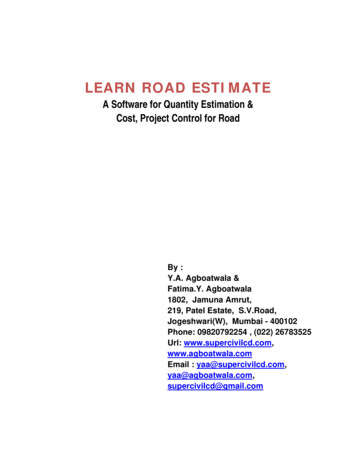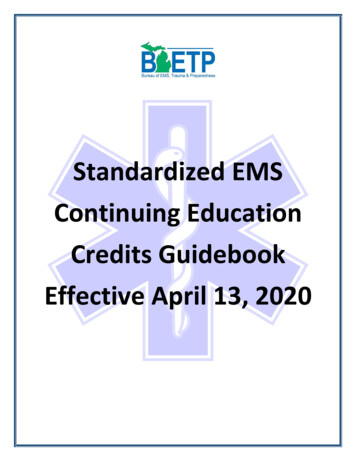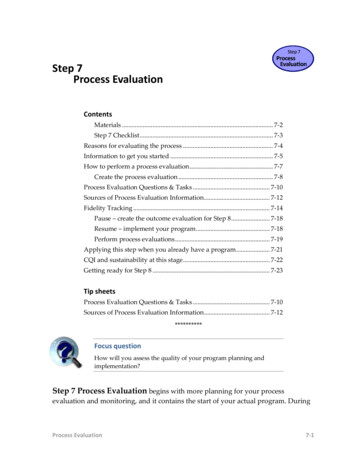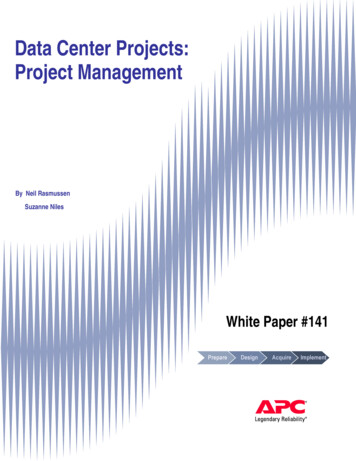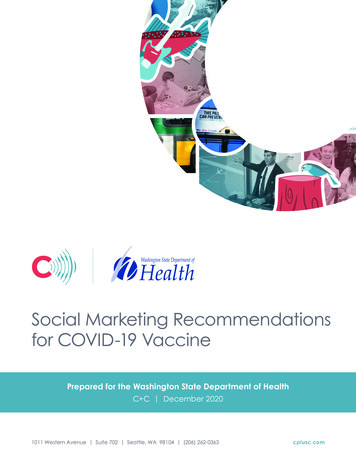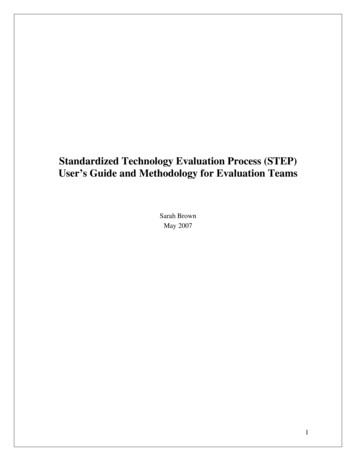
Transcription
Standardized Technology Evaluation Process (STEP)User’s Guide and Methodology for Evaluation TeamsSarah BrownMay 20071
Table of Contents123Introduction41.1 Purpose41.2 Background51.3 Intended Audience51.4 How to Use this Document5STEP Methodology72.1 Evaluation Phases72.2 STEP Workflow92.3 Tailoring STEP102.3.1STEP Workflow for Small Evaluation Teams102.3.2STEP Workflow for Single Product Evaluations11Guidance for Successful Evaluations123.1 Methods Used to Evaluate and Score Products4123.1.1Establishing Evaluation Criteria133.1.2Scoring the Products143.1.3Computing Weights153.1.4Computing the Overall Score for Each Product193.2 Communication throughout the Evaluation Process203.3 Ensuring Evaluation Integrity203.4 Creating an Evaluation Timeline21Phase 1: Scoping and Test Strategy224.1 Action: Conduct Preliminary Scoping224.2 Action: Scoping with Government Sponsor234.3 Action: Perform Market Survey/Tool Selection244.4 Action: Determine Test Architecture252
564.5 Action: Draft High-Level Test Plan254.6 Check Point – Phase 126Phase 2: Test Preparation285.1 Action: Establish Evaluation Criteria, Priorities, and Test Procedures285.2 Action: Perform Government Requirements’ Mapping295.3 Action: Enhance and Finalize Test Plan305.4 Action: Acquire Necessary Hardware and Software315.5 Action: Hold Technical Exchange Meeting (TEM) (optional)325.6 Check Point – Phase 233Phase 3: Testing, Results, and Final Report356.1 Action: Conduct Testing and Compile Results356.2 Action: Perform Crosswalk366.3 Action: Share Results with Vendors366.4 Action: Deliver Final Report376.5 Check Point – Phase 3397Acknowledgments418References41Appendix A Acronym and Definition List43Appendix B STEP Templates443
1 Introduction1.1 PurposeMITRE conducts numerous technology evaluations for its sponsors each year, spanning a widerange of products and technologies. In order to keep pace with rapidly changing technology andsponsor needs, MITRE evaluation teams require a well-defined evaluation process that isefficient, repeatable, and as objective as possible.The benefits of following a standardized, effective process include: Consistency and improved traceability through fixed steps and deliverables Improved efficiency leading to less effort required per evaluation Defensible, repeatable results Better communication within and among evaluation teams Evaluations that can be compared and shared more easily across the sponsor base An opportunity to develop guidance and document lessons-learned for future evaluationsThe Standard Technical Evaluation Process (STEP) developed in G024 outlines a rigorousprocess for technology evaluations of one or more COTS products1 . It applies to a variety of areasof technology and provides substantial benefits for evaluation teams and their governmentsponsors.STEP aims to provide: A process that can be used in a broad range of technology evaluations Standard deliverables to achieve consistency, traceability, and defensibility of theevaluation results Guidelines to assist teams in developing goals, documenting findings, and addressingchallenges A process that is recognized as comprehensive and fairThis document presents STEP and offers a guide to evaluation teams who wish to use it. Frompreliminary scoping to eventual integration and deployment, STEP guides teams in producinghigh quality reports, thorough evaluations, and defensible results.1Technology evaluation is used in this document to refer to evaluations of multiple products providing the samecapability. Product evaluation is used to refer to an evaluation of a single product.4
1.2 BackgroundIn 2004, the MITRE Intelligence Community Test and Integration Center in G024 begandeveloping STEP in an effort to track past evaluation work and ensure quality, objectivity, andconsistency in future evaluations. Since that time, STEP has been used successfully in G024 aswell as in G025, G027, and G151 evaluation tasks.The four phases of STEP follow a common framework for conducting a technology evaluation. Indeveloping and refining STEP, a variety of resources and subject matter experts were sought (seereferences in Section 8) within and outside of MITRE to gain a broader understanding ofevaluation theory and practice. The STEP workflow and methodology incorporate many of thesepractices and recommendations.1.3 Intended AudienceThis document is intended for MITRE project leads and engineers conducting technologyevaluations of one or more products and is suitable for experienced as well as first-timeevaluators. Although STEP was designed originally for several G024 security tool evaluations, theprocess and methodology is applicable to any software or information technology evaluation.Because evaluations may vary significantly in size and scope, STEP presents options forevaluation teams that would like to work in parallel for improved efficiency, as well as for smallerteams that wish to work together through each stage. Together, the STEP workflow andmethodology provide a comprehensive resource for teams wishing to standardize their evaluationsand structure their daily activities.1.4 How to Use this DocumentSection 2 of this document provides guidance on four major challenges in technology evaluations:using an established scoring method, communicating with the sponsor, ensuring integrity anddefensibility, and forming a realistic evaluation timeline.The remainder of the document provides specific information for executing each STEP action.The presentation in this document is based on the CEM Project Leader Handbook [8]. There is achapter for the three main STEP phases and the chapters are designed so that the reader canquickly locate information about a specific action. Each chapter contains: An overview of the phase A section for each action within the phase For each action:o Description: A description of the action and specific work to completeo Lessons-learned: Guidance for successfully completing the actiono Templates and Sample Deliverables: A list of templates and deliverables frompast evaluations to assist teams in documenting their work5
The final STEP phase, Phase 4: Integration and Deployment, is outside the scope of this documentand is not addressed in detail. Phase 4 applies if an evaluation results in a purchase decision by thesponsor. In this case, the sponsor determines the specific actions required.6
2 STEP Methodology2.1 Evaluation PhasesThe STEP process defines evaluations according to three main phases: (1) Scoping and TestStrategy, (2) Test Preparation, (3) Testing, Results, and Final Report, and a fourth, optional phase(4) Integration and Deployment that is determined by the sponsor on a case-by-case basis (Figure1). Each STEP phase has different objectives, actions and associated document deliverables.Checkpoints, or control gates, separate the phases, and each phase must be completed before thenext one is begun. These control gates help to ensure evaluation integrity. For instance, teamsmust establish their evaluation criteria and test strategy (Phase 2) before installing or testing theevaluation products (Phase 3). It is critical that the team solidify their evaluation criteria beforestarting hands-on product testing. This avoids the potential for introducing bias into the evaluationcriteria based on prior knowledge of a given product’s features or design.Figure 1: Four Phases of STEPBelow are short descriptions of each phase:1. Scoping and Test Strategy. During this phase, the evaluation team gains anunderstanding of the mission objectives and technology space, and settles on keyrequirements through scoping with the government sponsor. The team produces aproject summary to help clarify the objectives and scope, and performs a marketsurvey to identify potential products in the technology area. The evaluation team7
works with the sponsor to select a list of products for further evaluation based on themarket survey results, evaluation timeline, and resources available. To prepare fortesting, the team produces a project summary and high-level test plan.2. Test Preparation. After selecting the products to evaluate and obtaining concurrencefrom the sponsor, the evaluation team works to acquire the evaluation products fromthe vendors, and any additional infrastructure that is required for testing. Thisincludes signing non-disclosure agreements (NDAs), establishing vendor points ofcontact, and meeting with the vendor to discuss the test plan. At the same time, theteam develops a full set of evaluation criteria that the products will be tested againstand any scenario tests 2 that will be performed. The evaluation team then installs theproducts in the test environment, and engages the vendor as technical questions arise.The team may wish to hold a technical exchange meeting (TEM) to gain furtherinsight and background from subject matter experts.3. Testing, Results, and Final Report. In this phase, the evaluation team tests andscores the products against all of the test criteria. The team must ensure that testingfor each product is performed under identical conditions, and must complete a fullcrosswalk of the scores for each product requirement after testing to ensure scoringconsistency. Following the crosswalk, evaluation team members conduct individualmeetings with each vendor to review their findings, correct any misunderstandingsabout their product’s functionality, and retest if necessary. The team produces a finalreport that incorporates the evaluation results and any supporting information.4. Integration and Deployment 3 . The final evaluation report submitted to thegovernment provides a data source to assist in decision-making, but is not a proposalto purchase specific products. If the government decides to purchase a product, theevaluation team works with the government and other commercial contractors toassist in deploying and integrating the solution into the operational environment.Actions in this phase may include developing configuration guidance and supportingdocumentation. .2In a scenario test, product performance is determined in situation that models a real-world application. Theevaluation team must ensure that each product tested receives the same data and is in the same environment.Test results will be repeatable only to the extent that the modeled scenario and data can be reproduced.3Phase 4 is outside the scope of this document. It is not addressed in later chapters.8
2.2 STEP WorkflowFigure 2 presents the full STEP workflow. STEP is comprised of four phases separated bycheckpoints. Within each phase, most actions can be completed in parallel so that teams canmaximize their efficiency. The highlighted actions result in major document deliverables for thesponsor. Appendix A of this guide contains templates for completing each STEP action.9
Figure 2: Full STEP Workflow2.3 Tailoring STEP2.3.1 STEP Workflow for Small Evaluation TeamsFor small evaluation teams that wish to perform the STEP actions in a linear order, Table 1presents a recommended workflow.Table 1: Recommended Linear STEP WorkflowSTEP PhaseSectionPhase 1 - Scoping and Test Strategy § 4.1Phase 2 - Test PreparationPhase 3 - Testing, Results, andFinal ReportPhase 4 - Integration andDeploymentActionConduct Preliminary Scoping§ 4.2Scoping with Government Sponsor§ 4.3Perform Market Survey/Tool Selection§ 4.4Determine Test Architecture§ 4.5Draft High-Level Test Plan§ 4.6Check Point – Phase 1§ 5.1Establish Evaluation Criteria, Priorities & TestProcedures§ 5.2Perform Government Requirements’ Mapping§ 5.3Enhance and Finalize Test Plan§ 5.4Acquire Necessary Hardware and Software§ 5.5Hold Technical Exchange Meeting (TEM)(optional)§ 5.6Check Point – Phase 2§ 6.1Conduct Testing and Compile Results§ 6.2Perform Crosswalk§ 6.3Share Results with Vendors§ 6.4Deliver Final Report§ 6.5Check Point – Phase 3noneDetermined by sponsor10
2.3.2 STEP Workflow for Single Product EvaluationsWhile the full STEP workflow is designed for technology evaluations (evaluations involvingmultiple products), it can be modified for teams performing a single product evaluation. In thissituation, Figure 3 provides a tailored workflow.Figure 3: STEP Workflow for Single Product Evaluations11
3 Guidance for Successful EvaluationsIn developing STEP, project leads identified several key challenges in conducting technologyevaluations. The following subsections address the four challenges identified by MITREevaluation teams that are critical to ensuring an evaluation’s success: Methods used to evaluate and score products, Communication during the evaluation process, Ensuring evaluation integrity, and Creating an evaluation timeline.These challenges were echoed and addressed in several literature searches on decision making. Asstated in an article [6] on methods and best practices in evaluating alternatives:“There are many potential mistakes that can lead one awry in a task Some concernunderstanding the task. Others concern structuring the decision problem to be addressed. Stillothers occur in determining the judgments necessary to specify the [scores] These mistakesfrequently cascade ‘When this occurs, the [scores] provide little or no insight, contribute to apoor decision, and result in frustration with the decision process.”3.1 Methods Used to Evaluate and Score ProductsIn a technology evaluation, teams must evaluate and score products against a set of evaluationcriteria in order to determine the best choice to meet their sponsor’s needs. Teams must produce aclear assessment of the products and provide a rationale that can be used to make and justifydecisions. The process involves1. establishing a set of evaluation criteria and, as appropriate, dividing the criteria among aset of categories,2. determining a scheme for scoring products against the evaluation criteria3. providing a set of numerical weights to determine the relative importance of the criteriaand evaluation categories4. computing the overall score for each productTeams often use a spreadsheet such as the one in Table 2 to track the evaluation criteria, scores,and weights, and calculate the total weighted scores for each product (see Appendix B for thisEvaluation Criteria Template).12
Description of How to Testthe CriteriaWeight productP5scores Evaluation CriteriaCategory 1 TitleCriteria ACriteria BCriteria CCriteria D productP2scores productP3scores productP4scores #1.01.11.21.31.4 productP1scores Table 2: Spreadsheet for capturing evaluation criteria, weights, and tion-The following subsections provide guidance for accomplishing steps 1- 4 above. This guidancecomes from the multi-attribute utility (MAU) analysis, within the mathematical field of decisionanalysis. Decision analysis is concerned with providing a mathematical framework for decisionmaking, so that decision makers can rigorously and consistently express their preferences, in sucha way that their results can be readily and logically explained.Multi-attribute utility (MAU) analysis [1, 2, 3, 4, 5, 6, 7, 10, and 14] is a well-established decisionanalysis method that specifically addresses how to select one alternative from a set of alternatives,which is akin to selecting a particular product from a set of products in a given technology area.MAU analysis follows steps 1- 4 above to compute the overall score, or utility, of each alternativeunder consideration. By following the rules and principles of MAU analysis, evaluation teams canperform straightforward, rigorous, and consistent decision making. Furthermore, teams can backup the integrity of their results through an established scoring method that is recognized ascomprehensive and fair.3.1.1 Establishing Evaluation CriteriaIn preparing for the evaluation testing, the first step is to establish the evaluation criteria. This is akey step, because at the end of the evaluation, the results will be a reflection of how well the teamcreated their evaluation criteria. In order to generate these criteria, the team should conductindependent research and request guidance on all aspects and objectives of the problem from thegovernment sponsor and subject matter experts. Through this research, the team will ensure thatthe sponsor’s primary needs/wants are addressed, as well as critical functional (e.g. security)capabilities or nonfunctional (e.g., policy, vendor support) issues.Evaluation criteria should be specific, Boolean (two-valued) types of questions that are clearlystated and can be clearly tested. The following tips are provided for writing individual criteriastatements. First, use the “who shall what” standard form to prevent misunderstanding. In otherwords,13
Figure 4: Standard form for writing the evaluation criteriaIn writing these statements, avoid the following pitfalls listed in [13]: Ambiguity – write as clearly as possible so as to provide a single meaning Multiple criteria – criteria that contain conjunctions (and, or, with, also) can often be splitinto independent criteria Mixing evaluation areas – do not mix design, system, user, and vendor support criteria inthe same evaluation category. Wishful thinking – “Totally safe”, “Runs on all platforms”. Vague terms – “User friendly”, speculative words such as “generally”, “usually”In addition to the evaluation criteria statements, provide a description of how each criterion will betested. Following these tips will help ensure that each evaluation criterion is carefully written,independent, and clearly states what is tested, how it is tested, and the desired outcome.3.1.2 Scoring the ProductsThe next step is to determine how products will be scored against the evaluation criteria. Forexample, teams could use the following function ui: ui(ai) 0 if a product does not meet evaluation criteria ai ui(ai) 1 if a product partially meets evaluation criteria ai ui(ai) 2 if a product fully meets evaluation criteria aiThis function is a constructed scale because each point is explicitly defined. Constructed scales areoften useful because they allow both quantitative and qualitative criteria to be measured. Teamsmay prefer to assign scores based on a standard unit of measure (e.g., time, dollars), a complexfunction, or another function type.By convention, in MAU analysis, any scoring function should be normalized so that the scoresfall in the range from 0 to 1. Normalizing the above constructed scale gives: ui(ai) 0 if a product does not meet evaluation criteria ai ui(ai) .5 if a product partially meets evaluation criteria ai ui(ai) 1 if a product fully meets evaluation criteria ai14
Therefore, in the above example, a product that fully meets a criterion during testing will receive ascore of 1, a product that partially meets a criterion will receive a score of .5, and a product thatdoes not meet a criterion will receive a 0 for that item. These are not the only possible scalevalues. In this case we have a discrete set of three values. We could have a larger discrete set or acontinuous set between 0 and 1.3.1.3 Computing WeightsThe final step is to assign weights wi to each criterion. These weights serve as scaling factors tospecify the relative importance of each criterion. Because they are scaling factors that specifyrelative importance in the overall set of criteria, they should be nonnegative numbers that sum to1.There is no “best” method for choosing weights. The choice depends on the principles and axiomsthat the decision maker wishes to follow, level of detail desired for the weights, and the computingresources available for calculating the weights.A variety of methods have been proposed for eliciting weights [1, 2, 3, 4, 10, and 14]. Thesemethods include: Weighted Ranking Analytic Hierarchy Process (AHP) Trade-off method (also called Pricing Out) Paired Comparison (also called Balance Beam method) Reference ComparisonThese methods are compared in Figure 5 below and the Paired Comparison and ReferenceComparison methods are recommended for use by MITRE evaluation teams.The first three methods, weighted ranking, AHP, and the trade-off method, are not recommendedin this guide for the following reasons. Both weighted ranking [2, 9] and AHP [5, 10] are popularmethods, but they can be manipulated in ways that result in certain basic logical flaws, and as aresult, are often rejected by decision analysts as acceptable methods for computing weights [2, 4,11, 14]. The Trade-Off method [2, 3, 6] is also a well-accepted method, but is not recommendedbecause of the computational resources required to derive weights for more than 10 alternatives.Several commercial decision software packages are available that implement this method.The Paired Comparison and Reference Comparison [3, 9, and 14] are recommended in this guidefor use by evaluation teams because they are widely accepted and practical to perform by hand.The Paired Comparison is a good choice when deriving weights for 10-100 alternatives.Alternatively, the Reference Comparison method is a good choice when deriving weights for100 evaluation criteria. It requires fewer computations than Paired Comparison; however itprovides less granular weights.15
Can exhibitlogical flawsCan exhibitlogical flawsWeightedrankingReferenceComparisonPaired Comparison(Balance BeamMethod)Analytic HierarchyProcess (AHP)Trade-offmethod(Pricing Out)Time intensive, may require software;provides more granular weightsEasy to implement;provides relatively coarse weightsFigure 5: Comparison of Weight Assessment Methods. Reference Comparison andPaired Comparison are recommended in this Guide for evaluation teamsPaired Comparison:This method is a good choice for deriving weights for 10-100 alternatives and is best explainedwith an example. Given a set of evaluation categories or a small set of evaluation criteria,determine a basic ordering from highest importance to least importance. Throughout these weightassessment methods, basic orderings and relative importance is decided by the team and will besubjective.Example:Most important ABCDEFLeast important G16
For example, in an evaluation of a security product, security is the most important category,followed by auditing, administration/management, and then vendor resources.Starting with the alternative of highest importance, express its importance with the alternatives oflower importance in terms of a , , or relationship. There is no rule about coming up with thisexpression, it is determined by the evaluation team. Obtain an equality ( ) relationship wheneverpossible to make it easier to solve the equations at the end. Repeat this with the alternative of nexthighest importance, until each alternative is expressed in terms of lower-order alternatives, asshown:Paired Comparisons (Balance Beam Comparisons) RelationshipA B CA B DA B DB C DB C D GB C D EB C D FB C D GC D EC D GC D FC D FC D GD ED EE F GE 1.5 (F G)E 1.5 (F G)F 2GF 2GNext, assign the lowest-order alternative (in this case, G) a value of 1. Then back solve the systemof equations to determine values for the set of alternatives. The result in this example is:A 17.5B 11.5C 5.5 and C 6.5D 4.5E 4.5F 2G 117
Since the value for C is not exact, it can be approximated and assigned a weight of 6.The sum of these weights is 47, so to normalize the values, divide each one by 47. The resultingnumbers sum to 1 and give the weights. From A to G they are: 0.372, 0.245, 0.128, 0.096, 0.096,0.043, and 0.020.The paired comparison method can be used to find weights for the individual evaluation criteriaand/or for the evaluation categories themselves. The table below shows the weights correspondingto individual evaluation criteria.Description of How to Testthe -description-0.3720.2450.1280.096000000000000 productP5name Evaluation CriteriaCategory 1Criteria ACriteria BCriteria CCriteria D productP2name productP3name productP4name #1.01.11.21.31.4 productP1name Table 3: Paired Comparison Weights shown on Evaluation Criteria Template00000000Reference Comparison:The Reference Comparison method is an alternative to the Paired Comparison and is a goodalternative when calculating weights for 100 criteria. Given a set of evaluation criteria, choosethe evaluation criterion that is most important or significant in the set. Assign this criterion a valueof 3. Using this as a reference, rank the remaining criteria as follows4 : 3 the criterion is as important as the “reference criterion” 2 the criterion is slightly less important as the “reference criterion” 1 the criterion is much less important than the “reference criterion”Then, normalize these values so that they sum to 1.For example, suppose values are assigned as follows:A 3B 34It is not necessary to use the range from 1 to 3. The range can be less constrained or moreconstrained as needed.18
C 2D 2E 3F 1G 2The sum of these weights is 16, so to normalize the values, divide each one by 16. The resultingnumbers sum to 1 and give the weights. From A to G they are: 0.1875, 0.1875, 0.125, 0.125,0.1875, 0.0625, and 0.125.The reference comparison method can be used to elicit weights for the individual evaluationcriteria and/or for the evaluation categories themselves. The table below shows the weightscorresponding to individual evaluation criteria.Description of How to Testthe 0 productP5name Evaluation CriteriaCategory 1Criteria ACriteria BCriteria CCriteria D productP2name productP3name productP4name #1.01.11.21.31.4 productP1name Table 4: Reference Comparison Weights on Evaluation Criteria Template00003.1.4 Computing the Overall Score for Each ProductOnce the evaluation criteria, product scores, and evaluation weights have been determined, the nthadditive utility function is used to compute the overall score of each product, where n is thenumber of evaluation criteria.As an example, the additive utility function with two evaluation criteria, a1 and a2, is:u(a1, a2,) w1 u1(a1) w2 u2(a2)The variables in the function are: u, represents the overall score of a product over two evaluation criteria, a1 and a2 u1 and u2, scoring function(s) for criteria a1 and a2, respectively. For simplicity, teams canuse the same scoring function for each criterion. The scoring function example fromSection 3.1.2 demonstrated a constructed scale.19
w1 and w2, individual weights assigned to each criterion by a weight assessment method.The process of eliciting weights was described in Section 3.1.3.Therefore in summary, MAU analysis provides evaluation teams with a consistent, fairly rigorousapproach for scoring products in a technology evaluation. Teams must establish the evaluationcriteria; determine a scheme for scoring products; and weight the relative importance of eachevaluation criterion and category. The results are the collective efforts of evaluation teams, and aretherefore likely to have some inter-subjective consistency. After each product has been evaluatedand scored, the nth additive utility function gives the overall score (or utility) for each product andan overall product ranking.3.2 Communication throughout the Evaluation ProcessA successful evaluation requires effective communication between the evaluation team and thesponsor, stakeholders, subject matter experts, and vendors throughout the evaluation process. Theteam must understand what the problem is and what the solution is intended to accomplish.During each phase, evaluation teams should conduct status updates with the sponsor andstakeholders and/or subject matter experts, either in writing or as a briefing, to discuss and solicitfeedback on the following items: Evaluation goals and objectives Initial product assessments Additional products or currently deployed solutions within the sponsor’s environmentworth considering Considerations/requirements for the sponsor’s environment Evaluation criteria and the test planIn order to facilitate consistent, well-presented work during an evaluation that is recorded for laterreference, Appendix B provides STEP briefing and document deliverable templates for eachphase of the evaluation. In addition to ensuring good communication throughout the evaluation,the STEP templates also assist the team in drafting their final report.3.3 Ensuring Evaluation IntegrityIt is critical that MITRE teams perform evaluations that are recognized as comprehensive and fair.A fundamental requirement to achieving evaluation integrity is consistent documentation of testdata and methodology for review by the sponsor, stakeholders, and vendors if questions arise. TheSTEP actions and tips (Chapters 4-6) provide guidance for ensuring evaluation integrity. Theseguidelines include: Verifying all product information for a Market Survey/Tool Selection with productvendors, and requesting written explanations (by email) as needed20
Following the rules and principles for establishing evaluation criteria, scoring products,and weighting criteria, as explained in Section 3.1 Finalizing evaluation criteria, including associated weights, test procedures, and expectedoutcomes/guidelines for scoring before testing is begun. Highlighting product strengths and weaknesses as they are indicated in the overallevaluation scores. That is, the evaluation team must be careful not to call out productstrengths and weaknesses arbitrarily in the final report without quantitative results and/orjustification to back up the claims. Documenting the evaluation using STEP templates for consistency3.4 Creating an Evaluation TimelineScheduling is an important part of the evaluation process in order to establish realistic timelinesand expectations. The STEP workflow allows teams to identify the individual actions and estimatethe time required to complete each one. Teams may wish to break larger acti
MITRE conducts numerous technology evaluations for its sponsors each year, spanning a wide range of products and technologies. In order to keep pace with rapidly changing technology and sponsor needs, MITRE evaluation teams require a well-defined evaluation process that is efficient, repeatable, and as objective as possible.
